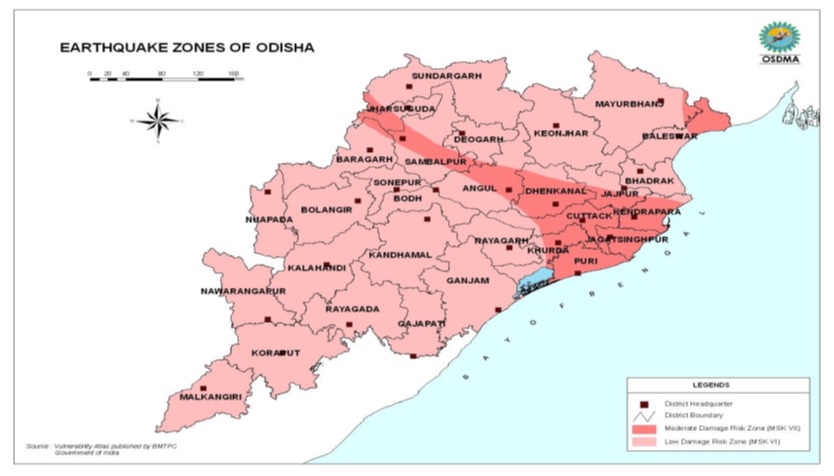Earthquake
Earthquakes are one of the most powerful natural forces on earth and regularly affect people around the world. Earthquakes can have a range of magnitudes with the strongest having devastating consequences for the areas where they are centered, nearby areas, and even some far away in the case of earthquake-gen erated tsunamis. Most earthquakes are quite small but are not readily felt. Larger and more violent earthquakes are those that occur in a release of energy as the plates slide past or collide into one another. Large earthquakes can focus on the boundaries where two plates meet, but they are not limited to these areas. As the plates move, fractures in the earth’s crust develop and earthquakes are often located on them. These fractures are referred to as faults, and all generate earthquakes when they move.
The most damaging earthquakes happen when the blocks of rock become locked together due to the intense friction created when they move. As they continue attempting to move once they are locked, pressure continues to build until it has enough energy to move the rock and the blocks move, creating an earthquake. The point where the energy is released is called the focus and the focal depth is the depth beneath the earth’s surface where the energy release originates. The epicenter is another term used in studying earthquakes and this is the point on the earth’s surface directly above the focus. From here, the energy released spreads out in rings moving across the surface – not unlike those caused when a rock hits still water. In addition to the main shaking created by an earthquake, there are often foreshocks and aftershocks. Foreshocks generally increase in magnitude leading to the main earthquake, whereas aftershocks happen after the main event and decrease in strength. Once an earthquake finishes its movement, its magnitude (strength) is determined with the Richter scale measures the energy released by an earthquake while the Mercalli scale measures the felt or observed intensity at a particular location.
The impacts of earthquakes vary based on their energy and intensity. The strongest earthquakes that occur can result in ground rupture, causing damage to bridges, dams, roads, railroad tracks, and the foundations of buildings. They can also cause landslides and avalanches as a result of the shaking. Intense shaking can also cause liquification of ground built on landfill when water mains break. The shaking of an earthquake is increased in areas of landfill.
Another major cause of damage is the fires that ignite when power lines fall and gas lines rupture. In addition, undersea earthquakes can generate tsunamis that are capable of traveling great distances from the epicenter and cause significant damage to coastal communities. In an effort to reduce the impacts of earthquakes, areas prone to them have taken steps to retrofit buildings and educate citizens (in schools and the media for example) on what they should do when an earthquake occurs. Knowledge of what to do and always being prepared for an earthquake is the best way to reduce injuries, deaths, and damage to cities and towns when they occur.
Records of historical seismicity indicate activity along the Odisha coastal belt. Current seismicity is related to activity along Gondwana Basin boundary faults and those associated with continent-oceanic crust transition zone in the Bay of Bengal. Within the Mahanadi coastal basin, several subsurface faults trending in E-W, NE-SW and NW-SE directions but mostly curvilinear in nature have been interpreted from DSS profile.
As per the recent categorization, the country has been divided into four zones (II, III, IV and V) and Odisha falls between Zones II and III i.e. low damage risk zone and moderate damage risk zones. However, it may be noted that major part of Gujarat, including Ahmedabad, also comes in the moderate risk zone but Ahmedabad City was badly affected by the impact of the Bhuj 2001 earthquake. The details of the location of the districts, according to seismic zones, are given in the Table below:
| District Coming Under Moderate Risk Zones (Zone-III) | Districts Coming Under Low damage Risk Zones (Zone-II) |
| Sundargarh, Jharsuguda, Bargarh, Sambalpur, Deogarh, Anugul, Dhenkanal, Jajpur, Cuttack, Khurda, Puri, Jagatsighpur, Kendrapada, Bhadrak, Mayurbhanj, Balasore. | Malkanagiri, Korapur, Rayagada, Gajapati, Ganjam, Kandhamala, Nawrangpur, Kalahandi, Nuapada, Bolangir, Sonepur, Boud, Nayagarh, Keonjhar, |
While the entire district of Jagatsighpur comes under the Moderate Damage Risk Zone only, parts of all other districts mentioned in the moderate risk zone also come under low damage risk zones. Apart from the State capital, important cities like Cuttack, Sambalpur, Bargarh, Anugul, Puri, important industrial installations, the Paradeep Port and the Hirakud dam also fall under moderate risk zone.
Although in Odisha there has been no reported occurrence of earthquake of high magnitude, the Odisha State Disaster Management Authority (OSDMA) regularly conducts mock exercise on earthquake at school level in the earthquake prone district of the state to educate and raise awareness amongst school children and general public on various aspects of earthquakes, their impacts and measures to mitigate losses awareness. Awareness is disseminated among public by displaying Do’s and Don’ts on Earthquakes safety in the website of OSDMA. For rescue operation after an earthquake the Odisha Disaster Rapid Action Force (ODRAF) personnel’s and Fire personnel are continuously being trained on Collapsed Structure Search & Rescue (CSSR) for response and evacuation in case of an earthquake.








